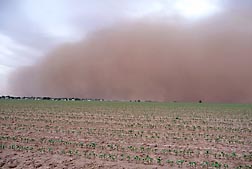This page has been archived and is being provided for reference purposes only. The page is no longer being updated, and therefore, links on the page may be invalid.
| Read the magazine story to find out more. |
|
|
Understanding Microbes Blowing in the Wind
By Dennis O'BrienFebruary 6, 2013
With help from a wind tunnel and the latest DNA technology, U.S. Department of Agriculture (USDA) scientists are shedding light on the travel patterns of microbes in soils carried off by strong winds. The work has implications for soil health and could lead to management practices that minimize the damage to soils caused by wind erosion.
Wind erosion is an emerging issue in soil conservation efforts. Agricultural Research Service (ARS) scientists have been studying wind-eroded soils since the 1930s, but few studies have focused on the effects of wind on the bacteria, fungi, and protozoa in the soil. ARS is USDA's chief intramural scientific research agency.
Researchers see an increasing need to focus on pathogens and agriculturally important bacteria carried in dust. ARS soil scientist Veronica Acosta-Martinez, with the agency's Wind Erosion and Water Conservation Unit in Lubbock, Texas, focused on bacterial populations that could be classified by DNA sequencing. She worked with Terrence Gardner, a visiting scientist from Alabama A&M University.
Researchers collected airborne dust and samples of a type of organic soil susceptible to wind erosion from fields where potatoes, beets and onions had grown a few years earlier and exposed them to windy conditions using a portable wind tunnel. They characterized the bacteria they found in both the "source soils" and the wind-eroded sediments, focusing on types of bacteria associated with coarse particles and on the types associated with fine dust particles.
They classified the bacteria found in each type of soil and wind-eroded sediment using pyrosequencing, a process that allowed them to identify up to 100 times more DNA in each sample than they would have detected with traditional methods. The study results, published online in the Journal of Environmental Quality, showed that certain types of bacteria, known as Bacteroidetes, were more predominant in the fine dust. Other types, known as Proteobacteria, were more predominant in coarse sediments.
Studies have shown that Bacteroidetes resist desiccation and thus can survive in extreme conditions when carried long distances. The fact that Proteobacteria were associated with coarse eroded sediments, which travel shorter distances, may explain how soils can retain important qualities despite damaging winds. Proteobacteria play an important role in carbon and nitrogen cycling, and their fate in dust storms will be the focus of future research, according to Acosta-Martinez.
Read more about this research in the February 2013 issue of Agricultural Research magazine.

